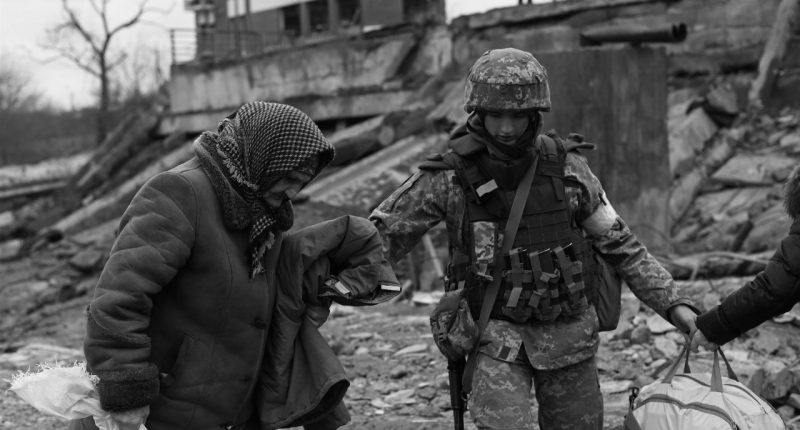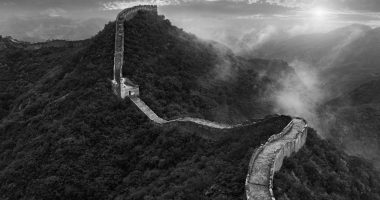Who hasn’t balked at the graphic imagery of bloodied, traumatised Ukrainian residents trapped under Russian bombardment and the ruins of their besieged cities?
The alacrity with which much of the world — including Australia — has rallied and offered sanctuary to millions of Ukrainian refugees without reservation is remarkable and right. Russia’s barbaric, indefensible invasion more than a month ago, transforming Ukraine into killing fields, bombed-out wastelands and humanitarian disasters, has struck at the core of humanity and democracy.
Casualties, including more than 1000 civilians, are mounting as the world hurls unprecedented boycotts at Russia and economic war escalates.
But the rush to accept Ukrainian refugees has highlighted the inequity of Australia’s policies on refugees already in Australia, and the lack of reform.
Australia’s recent deal with New Zealand to resettle 450 refugees over the next three years is a step forward, long overdue. The incarceration of refugees almost a decade ago when New Zealand first made the offer does nothing to assuage the prolonged damage done to hundreds of wasted lives used to political advantage.
Under the agreement, those on Nauru and temporarily in Australia under regional processing arrangements are eligible for resettlement in New Zealand. It precludes those on other resettlement paths, such as the United States, and those left in Papua New Guinea after Australia closed offshore processing there in December, although the UNHCR is negotiating separately with New Zealand.
The government has long opposed the arrangement, concerned it would encourage the resumption of asylum-seekers trying to reach Australia by boat and that refugees might enter Australia through the backdoor after resettling in New Zealand.
Under the deal, those resettled in New Zealand will not be eligible for visas that provide a path to permanent residency, citizenship or settlement in Australia, the Australian Department of Home Affairs said.
However, many refugees will breathe a sigh of relief. Thousands will remain in limbo. Clearly, the government is committed to temporary visas, tough border policies and the denial of permanent resettlement to refugees who arrived by boat.
Which brings me back to comparisons between the treatment of refugees in Australia and those in Ukraine — both groups hapless victims of war.
Refugee activist Ian Rintoul from the Refugee Action Coalition calls it a sickening hypocrisy. “There is an obvious double standard in regard to the government’s attitude to Ukrainians and other asylum seekers who are displaced by war; for instance, the Afghans, Iraqis, the Rohingya, the Tamils,” he said.
“The difference is, of course, that the government’s attitude to the Ukrainians gels with its overall foreign policy position. In most of the other cases, it is the government which has been responsible — at least, in part — for the displacement of those who were fleeing war. It was US bombs supported militarily by Australia in Iraq and Afghanistan that led to people fleeing those countries.”
Indeed, the Ukrainian crisis not only accentuates the need for immigration reform but the selectivity of refugees widely considered to be ethnically-based.
What is the prognosis, for instance, for the massive global back-up of persecuted Middle Eastern, Asian and North African asylum seekers and refugees? Those whom no one wants, who much of Europe has repelled with massive walls while simultaneously welcoming Ukrainians. Anti-refugee laws — to stop boat arrivals, people-smuggling and drownings at sea — remain strong, and the major parties are in lockstep on the boat turnback policy implemented in 2013 and mandatory and offshore detention.
Refugees stuck on bridging visas are disallowed family reunion, travel, or permanent residency. It’s a moot point whether Labor will make reforms, should it win the May federal election. It has outlined it would grant permanent visas to those in the community on temporary protection visas and safe haven enterprise visas. There is no promise to grant detained refugees permanent visas.
The rationale for an overhaul is not just a humanitarian gesture. The current average monthly cost to Australian taxpayers for every refugee and asylum seeker held on Nauru spiralled to $358,646, or $4.3 million per person a year, despite dwindling numbers since 2016, a Guardian Australia analysis reported. The government refused to divulge where nearly $400 million spent on offshore processing went.
It’s money that could have been invested into the community by refugees taking up and creating jobs and generating returns.
The benefit a host country derives from keeping a hidden underclass of impoverished people powerless serves only to reinforce harsh, punitive policies. In contrast, the advantages of migration — including refugees — are economic and social. Take, for example, increasingly ageing populations: migrants help offset shortfalls in the workforce and fill important niches in fast-growing and declining sectors of the economy, as one OECD study notes.
The act of migrating and fleeing to further-away countries, in the case of refugees, in itself, is associated with risk-taking behaviour. So, migrants are more likely to take risks also in business, creating new ventures, the Brookings Institution says.
“Small firms, in turn, are the engines of job growth. In the US they create about 1.5 million jobs every year,” it says. “As opposed to taking jobs away from native citizens, they create new jobs.”
Invariably multilingual, refugees frequently act as interpreters and have demonstrated work-based flexibility typically stemming from surmounting hardship.
The back-up of refugees, particularly ethnic Afghan Hazaras, long before the Taliban’s takeover, is evident in our own backyard. Indonesia, a non-signatory to the 1951 UN refugee convention, does not allow refugees access to work, education or health care. As a transit country, people await resettlement to a third country such as Australia, which is legally responsible to protect them after formal recognition of their claims.
I have witnessed the demoralisation and desperation of hundreds of the near 14,000 refugees stranded in Indonesia for 10 to 15 years, most of whom had their hopes set on Australia because they saw it as a safe haven offering a decent life, and many had families here. The pathways closed when asylum seekers who arrived in Indonesia after mid-2014 were no longer eligible for Australian resettlement. They have less than a one per cent chance of resettlement anywhere, the UNHCR head told me.
Of hundreds I interviewed, most were multilingual with varying skills. They had scraped together money to pay people smugglers to flee conflict and persecution from countries where, frequently, relatives had been murdered. Some were unaccompanied children whose families had sent them away, fervently hoping they would be safe. Most had attempted perilous boat journeys to Australia; some had lost small children en route.
For their efforts, they were confined to brutal detention centres. Others, accepted by the US, Canada or New Zealand, have built new lives.
Rintoul has raised the problem of those stranded in Indonesia with the Labor Party but so far sees no headway.
I interviewed one of the last refugees allowed into Australia from Indonesia in 2014. After surviving one of the worst asylum seeker disasters in which 200 people drowned en route to Christmas Island, the Iranian political refugee persevered through UN channels to achieve refugee status and is now an Australian citizen. Yaser Naseri, aged 40, speaks fluent English, has a Bachelor’s degree in business from Sydney University and works in commerce. On an altruistic note, he volunteered for the Australian Red Cross, interprets globally for Iranians, and mentors refugees.
Refugees have recently crowded his social media accounts, criticising Australia’s “biased” system, citing Australia’s prioritisation of Ukrainian refugees for visas allowing them to work, study and access Medicare.
“In less than a day, Ukrainians get visas . . . refugees pay taxes here and everything is a struggle. The system discriminates so much.”
Rural and regional areas, which have suffered dire labour shortages, particularly during the pandemic, are crying out for workers.
One who has filled a void is Benham, an Iranian refugee and registered nurse whose decade-long battle to stay in Australia is only matched by his passion for work. At the height of the second COVID-19 outbreak last year, he stood at the frontlines, vaccinating older, vulnerable Australians. “I’m just happy to be able to contribute to the community,” he replied when I asked if he feared infection.
The political refugee holds a safe haven enterprise visa (SHEV), 10 years after embarking on the well-trodden asylum-seeker boat route from Indonesia in 2012.
His five-year renewable visa is just a theoretical pathway to permanency. The criteria is littered with roadblocks facing the nearly 19,000 refugees on temporary protection visas, who are also ineligible for resettlement in New Zealand.
“SHEV holders filling important labour roles and running small businesses commonly do not meet current criteria (for permanency),” the Refugee Council of Australia points out.
Following a five-month stint in Christmas Island’s detention centre, Benham, who chose not to reveal his surname, was released into the community with brief, limited government support and found work as a kitchen-hand and nursing home carer.
After studying for three years, he achieved his dream job as a registered nurse. But his past is the barrier to permanency. No one who attempted to travel to Australia by boat is allowed to stay.
Suspended in a type of twilight zone, refugees on bridging visas are not permitted to travel outside Australia except with permission from the Department of Home Affairs in extraordinary circumstances.
“I love Australia, my life is established here, I have a lot of friends here. But I can’t stay on a temporary visa, I miss my family,” Benham said.
One of hundreds trapped in limbo, he would have to surrender his refugee status if he travelled. “Really, the government is trying to pressure people to return to their home countries,” says Rintoul.
A 2021 Curtin University study makes the salient point that around 90 per cent of temporary protection visa holders are at peak earning ages — under 45 — and have functional English skills. Many also have sought-after work experience as chefs, personal carers, construction workers, carpenters, builders and plumbers.
Permanency would lead to better labour market outcomes and incentivise domestic consumption and investment. Labour force participation rates would increase 23 per cent and unemployment would be more than halved, the study notes. Fiscal savings of more than $300 million would be made by simply reducing the cost of reprocessing visa applications.
If migrants could upgrade skills, grow businesses, employ workers and integrate into local communities, the long-term economic returns would be invaluable.
“A pathway to permanency represents a win-win scenario for these aspiring new Australians and for the Australian community as a whole, boosting our supply of ready and able workers when we need it most,” the study says.
What New Zealand gains may be Australia’s loss.
Deborah Cassrels was The Australian’s first Bali-based correspondent and has written extensively on refugees, politics, terrorism, crime and social justice. She was nominated for a Walkley Award in 2016 for her work on terrorism in Indonesia. Her first book, a memoir about her journalism in Indonesia, titled “Gods and Demons”, was published in 2020.






